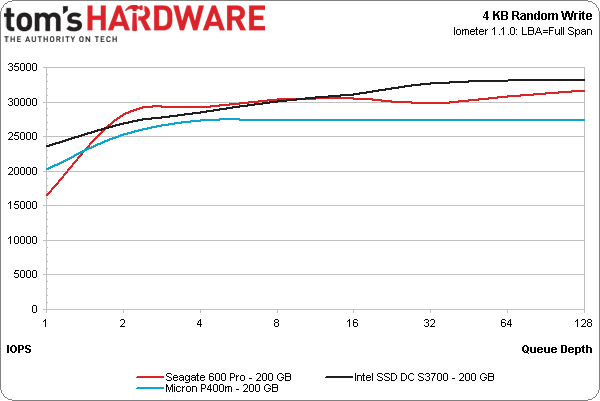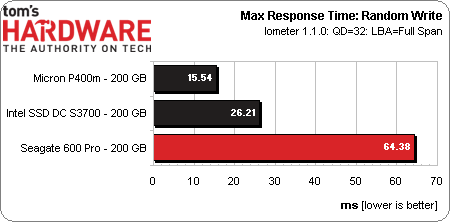Seagate 600 Pro-Series 200 GB SSD Review: For The Enterprise
After years of halfhearted attempts to join the solid-state storage market, Seagate is finally ready to reinvent itself with a new family of SSDs. The first one we're looking at is the enterprise-class 600 Pro. Does this 200 GB drive impress our team?
Results: 4 KB Random Performance And Latency
Given that Seagate's 600 Pro is a read-focused SSD, it must be good in read performance. Offering up to 84,000 IOPS, the 600 Pro isn't merely adequate in this discipline. It does great. It separates itself from Intel's SSD DC S3700 and simply crushes Micron's P400m at high queue depths.
How does the 600 Pro hold up in write testing, though?
Perhaps a bit surprisingly, the 600 Pro holds its own against the Intel and Micron offerings. In general, it's slightly faster than the P400m and just behind the SSD DC S3700. Considering a significant price difference, Seagate shows it can compete against heavier-weight competitors.
Looking at average response time, the 600 Pro falls roughly where we expect it to. Our maximum response time measurement is a little more troubling. The 600 Pro's ceiling is more than two times higher than the SSD DC S3700 and quadruple the P400m.
As we know, average response time masks spikes, while the instantaneous maximum doesn't reflect the frequency of them. In order get a clearer picture, we need to dig into performance consistency.
Get Tom's Hardware's best news and in-depth reviews, straight to your inbox.
Current page: Results: 4 KB Random Performance And Latency
Prev Page Results: Write Endurance Next Page Results: Performance Consistency-
mayankleoboy1 1. Would it have made sense to add more DRAM to increase performance ? On a SSD this expensive, 1GB RAM would hardly add 20$ or so.Reply
2. On the first page, the fourth paragraph :"Today, Seagate ........... bench today."
You completely went over my head. It appears you are just throwing names around. Maybe reword that para again ? or explain here ? :) -
Lrxst WD bought SiliconSystems in 2009 and has been making WD branded SiliconDrives. I put one in my i5 build shortly after they came out, and I feel like I am the only one who bought one for home use. They still make them, but are focusing on embedded systems at this point. Maybe Seagate will have more luck, but there are a lot of well established players already. I'm pretty luke-warm on Seagate. How do you know your Seagate SSD is on the verge of failure without the telltale Seagate Click of Death®?Reply -
drewriley mayankleoboy11. Would it have made sense to add more DRAM to increase performance ? On a SSD this expensive, 1GB RAM would hardly add 20$ or so.2. On the first page, the fourth paragraph :"Today, Seagate ........... bench today." You completely went over my head. It appears you are just throwing names around. Maybe reword that para again ? or explain here ?Reply
1) With the DRAM-to-NAND ratio already being 1MB->1GB it is already fairly aggressive, it may have helped with performance consistency, but I don't think you would see much improvement.
2) Basically, Seagate announced 4 products today
a) Seagate 600 Pro - Entry level, read-focused, enterprise SSD
b) Seagate 600 - Consumer SSD, which we will have reviewed tomorrow
c) Seagate 1200 - High-end, dual-port, 12Gbps SAS SSD
d) X8 Accelerator - High-end plug-in PCIe SSD
Hope this helps.
Drew -
drewriley LrxstWD bought SiliconSystems in 2009 and has been making WD branded SiliconDrives. I put one in my i5 build shortly after they came out, and I feel like I am the only one who bought one for home use. They still make them, but are focusing on embedded systems at this point. Maybe Seagate will have more luck, but there are a lot of well established players already. I'm pretty luke-warm on Seagate. How do you know your Seagate SSD is on the verge of failure without the telltale Seagate Click of Death®?Reply
You're the one that bought that drive :-) You are right on point with WD/Silicon Systems. They were primarily an embedded flash vendor prior to acquisition. If you look at their webpage, you will see that they only offer SLC-based drives.
-
mayankleoboy1 drewriley1) With the DRAM-to-NAND ratio already being 1MB->1GB it is already fairly aggressive, it may have helped with performance consistency, but I don't think you would see much improvement.2) Basically, Seagate announced 4 products today a) Seagate 600 Pro - Entry level, read-focused, enterprise SSD b) Seagate 600 - Consumer SSD, which we will have reviewed tomorrow c) Seagate 1200 - High-end, dual-port, 12Gbps SAS SSD d) X8 Accelerator - High-end plug-in PCIe SSDHope this helps.DrewReply
Thanks, Drew. This made the paragraph clearer. -
thecynicalmonk "For The Enterprise" Bout time the USS Enterprise got an upgrade! No more waiting for the holo-deck to buffer!! lolzReply -
danwat1234 "For The Enterprise", lol they use isolinear rods and chips. I doubt these SSDs can compete against those at any angle. Maybe from a reliability perspective.Reply -
rgeiken I have had several Seagate drives in the past and they both had reliability issues after their first year. Right now, Seagate is on my Do Not Buy List!!!! For any magnetic hard drive, I would select WD. Have had pretty good luck with that company. When any company produces parts that fail prematurely and then don't supply a replacement promptly, then they are on my DNB List. I will probably buy a Samsung SSD shortly, since with Samsung I have always had good performance and reliability.Reply -
bards1888 The DRAM on the SSD is typically only used to store the indirection table, it does not cache user data.Reply



